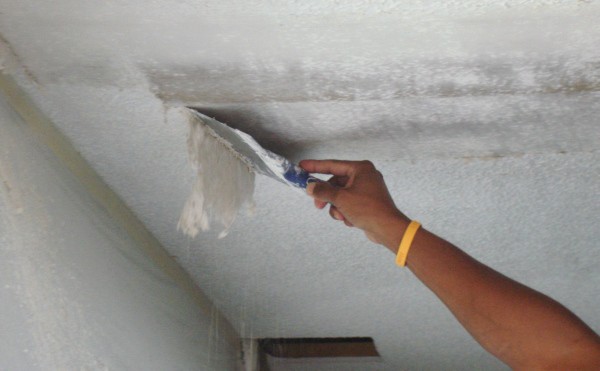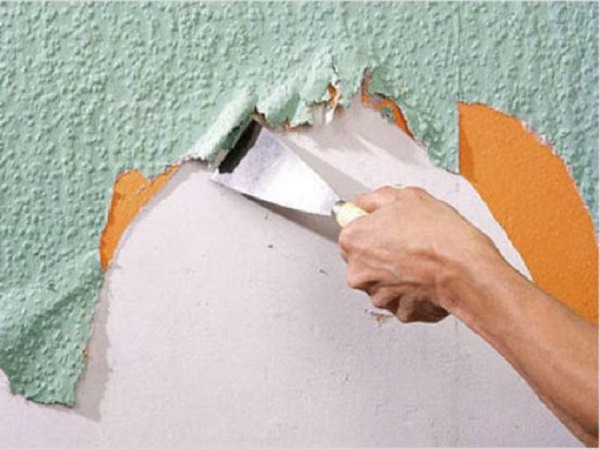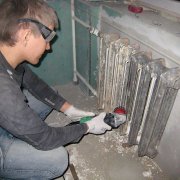How to remove paint from the ceiling: do it yourself
Painting the ceiling begins with the preparation of the base plane. Sometimes it is enough just to putty it. But many people have a problem with removing the old coating. How to clean the ceiling of paint and glue residue, we will consider today. You can look at some moments in a photo and video.
The content of the article
Removing dye from the ceiling
Since ancient times, the most popular ways of decorating the ceiling space were ordinary painting or whitewashing (seeDo-it-yourself whitewashing of the ceiling with water-based paint) Then, wallpaper, which glued the upper room level, was especially popular.
With the development of new technologies, it became possible to make the ceiling unusual and original. But with any finish you need to remove the old coating. Everything can be completely done independently and the issue price will be much lower.
Before starting restoration work, it is necessary to get rid of the remnants of old finishing building materials, since the final result depends on the cleanliness of the working coating.
Preparatory work
Paint on the ceiling is applied only to the prepared plane and even. When conducting repairs only after completion of the ceiling work, they are taken for walls and floor.
Attention: First you need to check the plane for its evenness. If there are large differences, then it will be necessary to level it and this is another article on ceiling plastering.
- Preparation for interior decoration begins with the release of the room from furniture. Non-separable lighting fixtures and decoration elements, flooring, door and window openings should be covered with polyethylene, cloth or large paper sheets.
- When carrying out major repairs in the cold season, it is very important that the room temperature does not drop below +5 ° C.
Ceiling Cleaning Tools
The quality and durability of the repair activities that are carried out depend on the correct choice of the used building materials and tools.
Mandatory Toolkit:
- Set of spatulas;
- Paint brushes and rollers, different in size;
- Steady ladder.
Attention: At the preparatory stage, pay attention to the availability of personal protective equipment. You have to constantly look up, so protect your eyes with glasses. Put a hat on your head and rubber gloves on your hands.
How to get rid of an old whitewash
Previously, the ceiling was whitewashed annually, so the thickness of the white forms a decent layer. It is recommended to remove it in small parts, without rushing, so as not to accidentally damage the base.
- In advance, part of the area to be cleaned is moistened with warm water and left for 20 minutes;
- The whitewash swells and begins to exfoliate from the ceiling, it remains just to remove it correctly ..
- It will be more convenient to use a small metal spatula. It is necessary to clean the surface very well so that no white particles remain. A spray is used, which alternately moisten the treated areas.
The procedure for removing a thin bleaching layer:
- The site is moistened and cleaned with a spatula.
- The treated area is checked for “flaws”
- If there are defects, then they can be easily removed with a wet sponge.
Water-based coating removal
Do not forget about tips for using personal protective equipment.When you remove the water emulsion from the ceiling, splashes from the roller may get into your eyes.
Effective removal of water based paint:
- Initially treated area requires abundant moisture. The most convenient tool to carry out will serve as a paint roller on a sliding rod.
- The paint roller needs to be well saturated with water and with it moisten the water-emulsion layer. The presence of dripping drops indicates the use of paint with a water-repellent effect in the past. To soften such a material, several attempts at soaking are necessary.
- After repeated surface treatment with a rollershould wait some time. This is necessary so that the entire layer of the water emulsion is wet and softened.
- After sufficient swelling of the paint, you need to take a spatula and scrubbing to remove the wet layer. To prevent accidentally breaking the base of the ceiling, keep the spatula parallel to the surface.
- In addition to a metal blade, you can use a grinding machine. With its help, it is also easy to remove water-repellent paint. The disadvantage of this method is the huge amount of dust that will penetrate into all corners of the renovated room. It is recommended to resort to a similar method of machining in extreme cases.
Many inveterate finishers know the simplest and most convenient way to eliminate an old water emulsion.
- For its implementation, you need a pile of newspapers, PVA glue (can be replaced with starch paste). The technique consists in applying glue to the ceiling with a roller, then pasting the surface with newspapers.
- The paper layer is removed after drying. If there are difficulties when removing the newspaper layer, then use a narrow spatula. Paper leaves with ink.
Note: Finishing professionals advise using sandpaper and polishing the treated areas to remove all residual defects.
Remove traces of glue
Old spots and yellow streaks of glue very often remain after wallpaper removal (see How to remove wallpaper from the ceiling: instructions) Naturally, for subsequent high-quality repairs, they must be cleaned.
The correct removal of perennial wallpaper:
- We abundantly wet the wallpaper with a wet roller. In several places, the paper should be cut - this will contribute to a deeper penetration of moisture.
- Get a special chemical product that allows you to remove old wallpaper without any difficulty. This composition must be treated surface. Proceed to the next work after half an hour.
Glue stain control algorithm:
- A solution for washing is applied to the necessary areas with a paint brush. The solution should be well absorbed for some time.
- Using an iron brush or a wide spatula, mechanically remove glue and perennial whitewash.
- With a wet brush they clean the surface. Thus, all residual fines are removed.
- In conclusion, the ceiling is washed with warm soapy water and completely dried.
Remove oil paint
To clean the oil paint from the ceiling is problematic. Its main property is a good adhesion to the surface, so it is sometimes possible to release the ceiling only when using reagents or alternative recipes.
Tools:
- Special chemical wash;
- Caustic and soda ash;
- Slaked lime;
- A piece of chalk;
- Putty knife;
- Iron brush.
Wash reagent is very good to use on a freshly painted surface. If the coating is applied relatively recently, then washing will do an excellent job. There is instructions on the package. The substance is very dangerous, so use protective equipment for eyes, hands and head.
- You can also successfully deal with a painted coating with a homemade composition.Caustic soda, chalk and slaked lime are mixed in a 1: 1 ratio. The mixture is wetted with water until a paste. The paste composition is applied to the surface. After several hours, the oil paint can be removed without problems with an ordinary metal spatula.
- Another way to remove oil paint is to heat it with a building hairdryer. The disadvantage of this method is that a lot of effort and time is spent on each site. However, using a hairdryer does not have to use chemicals. This fact is a plus in terms of safety of work.
How to remove paint from the ceiling you already know. If you do everything qualitatively, then the paint of the ceilings will lie evenly and will last for many years.









It’s not always possible to take off with a staple; there is a nozzle on the grinder in the form of a brush. Removes paint and whitewash to the concrete, quickly, but also very dusty!